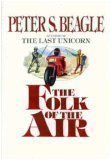 The Folk of the Air by Peter S. Beagle
The Folk of the Air by Peter S. BeagleMy rating: 3 of 5 stars
When people talk about the books Peter S. Beagle has written, this one usually winds up as a footnote. I ran across a copy at a used bookstore, though, and thought it sounded like something I'd like. Then it languished on my shelves, unread. Hence its inclusion in my 2014 TBR Challenge.
The book starts with Joe Farrell returning to his hometown of Avicenna, California. His best friend, Ben, is dating an older woman, and they have a spare bedroom he can borrow until he figures out what his next step is. Then he runs into Julie Tanakawa, an old flame. She introduces him to the League of Archaic Pleasures, a medieval reenactment society. He fits right in, but not before getting on the bad side of their resident sorceress, Aiffe, who can do real magic. Farrell feels sympathy for her when she summons a powerful being, Nicholas Bonner, who she can't control. She has no use for his sympathy, though, being convinced she's the one with the power. Her hubris leads her to confront Ben's lover, who is no mere human, herself.
This was written when urban fantasy was still very new, so it has the feel of trying on a few tropes and tones for size. I don't think Farrell was the right perspective character for the book; his flippancy lends itself to a sense of distance from the story, and he has nothing to do in the crisis point but observe. He's a fun character, and very typical of Peter Beagle's heroes, but I don't think this is his story.
There are several remarkable features to this book, though, which might make it worth the read. First, the language and imagery are lovely. Very evocative. As ever, Beagle conjures images with such turns of phrases that he makes it look easy.
Second is the diversity of the cast. Julie is of Japanese descent, and there are several other nonwhite people in Farrell's social group, many of whom get speaking roles. There's also a diversity of body types. Farrell notes there are a number of larger bodies at the League, and feels no need to share his opinion about their shapes. None of them are described as stuffing their faces, desperate for attention, or ungainly and unable to walk five steps without being out of breath, as fat people are often portrayed in modern media. The most desirable woman in the book is described as being in her 60s with a big belly. It astounded me, that anyone could even get into the mind set to write that with sincerity.
I need the people writing to the trend of fat heroines to look over this book, please. This is how it's done.
As much as I loved the writing and the characters, this book never spoke to me. It felt like a meandering, slice-of-life story with magic and people playing dress-up. The narrative thread was too thin, and, as I noted above, the conclusion described what Joe Farrell saw. He had nothing to contribute at the climax, no reason to be there except as an observer. I'm a lot more interested in the story this book seemed to be setting up at the end.
View all my reviews
No comments:
Post a Comment
Note: Only a member of this blog may post a comment.